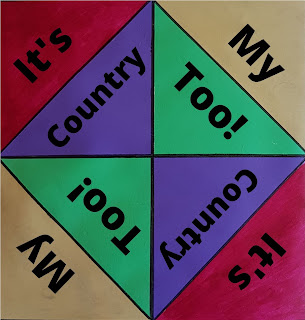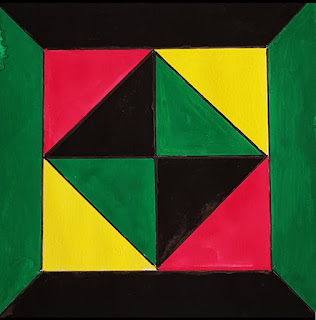Geometric Abstract Series #2:
No To Racism No 1/2
2021
Transparent Watercolour
5 x 5 inchesThis is the second of a series of geometric abstract paintings, using the Kuba design of eight triangles within a square. Still feeling inspired by African American artist Faith Ringgold's Love Black Life, particularly its colour scheme.
I did a modification No To Racism No 1/2 and as per the previous painting Being Black, Being Abstract, Being Invisible 1/2, I used four colours: Pelican Transparent Watercolours this time — Carmine Red, Prussian Blue, Lamp Black, and Ultramarine Blue. This combination of colours isn't of my choosing as I tend to prefer vibrant colours. Sometimes, it's a good idea to go against your own idea of what colour scheme might work. I do like how striking the Carmine Red is against the remaining colours.
Geometric Abstract Series #2:
No To Racism No 2/2
2021
Canva Graphic Design
4.75 x 4.75 inchesYou could say that the No To Racism No 2/2 is a semi-abstract piece, since it incorporates text using a Canva graphic design adding a very different dimension.
I like that one abstract piece can be used graphically. This eliminates the idea of writing the actual words freehand on the original. There's something really satisfying about making two pieces of art from one!
Culture, Community, Identity:
No To Racism was integrated as a symbolic gesture into my Birkbeck College Culture, Community, Identity assignment completed in April 2022. The assignment involved discussing the civil unrest of 2011 and whether this event was the culmination of decades of discriminatory and violent policing.
The civil unrest of 2011, more widely known as the London riots, erupted as a result of a 29 year-old Black man, Mark Duggan, being killed by the police on 4 August 2011, in Tottenham, north London.
In my assignment, I discussed how decades of discriminatory and violent policing played a significant part in the London riots. I considered the debates relating to policing and resistance in Britain and explored the range of reactions to the riots that included government responses, rioters' perspectives, and those of the police themselves and discussed whether police violence has changed.
I included my own reactions to the London riots; Birkbeck College encourages students to illuminate our own arguments throughout assignments thereby foregrounding our own voice rather than the work of other writers.
I shared my reaction to the London riots by way of a visit on 24 August 2021, to the Institute of Contemporary Arts exhibition: War Inna Babylon: The Community's Struggle for Truth and Rights, curated by Tottenham Rights activist, Stafford Scott. Here is an excerpt that depicts a reflection ten years on of my memory at that time:
I remember the police killing of Mark Duggan particularly well because I was working in Tottenham at the time. But that wasn't all. I was close enough, (Edmonton, north London) to know that something appalling was going on. I and many Black people I know watched in horror at the TV footage of Duggan's killing and we were outraged by it. And the outrage led to anger when the police refused to communicate with Duggan's family members as they congregated quietly and humbly outside Tottenham police station. The missed opportunity of a decent and respectful communication was the downfall of the police and elicited yet more distrust and lack of faith than ever before. The nationwide uprisings that followed were inevitable yet could have been avoided.
War Inna Babylon:
The War Inna Babylon exhibition shone a light on the collective action, resistance, and grassroots activism of Black communities across the UK in response to over seventy years of societal and institutional racism, in particular how the resuscitation of the Victorian Vagrancy Act 1824 in the form of the 'Sus' law gave rise to a generation of Black youth who were harassed and criminalised as a whole.
Violent Policing:
It is widely known in general, that the use of force by the Metropolitan Police has increased over the last couple of years, with Black people four times more likely to have force used against them than white people.
I have witnessed TV footage many times of police officers' 'treatment' of Black people as if they are sub-human, who in the process of policing often dehumanise innocent people and use discriminatory practices and behaviour. In this context, Black bodies are not valued, and Black lives are seen as expendable and often criminalised by the police from a very young age, leading to adultification, as in the recent shocking case in 2020 of a fifteen-year-old Black schoolgirl known as 'Child Q', who was strip searched in her school in Hackney, East London, while menstruating.
Police Injustices:
Civil unrest is often sparked as a result of police injustices and police brutalities and ignited when those injustices are integrated with a failure by the government and the police forces to fully understand the complexities of urban, social, economic, political, and cultural challenges that continue to permeate inner city residents.
Decades of discriminatory and violent policing played a significant part in the civil unrest of 2011, despite the unrealistic reactions and superficial narratives from the government and the police themselves that criminality was the cause. The police continue to deny that they were, and still are, a big part of the problem, and therefore remain a big part of the solution.
Institutional Racism:
However, failures in policing Black people are clear to see by the general public and the media despite the denial of institutionalised racism that is embedded in the UK police forces, especially the Metropolitan Police Service.
The denial of institutional racism continues to blame and stigmatise marginalised communities rather than investigate how disappointed those marginalised communities actually have been historically, and still are today, with being treated unfairly by oppressive and repressive policing tactics, that stem from discriminatory and violent policing.
The Way Forward:
There is so much more that needs to be explored by way of media and political commentary that contributes to rather than detracts from the realities of discriminatory and violent policing.
Fortunately, I sense hope that a new generation of young people who have peacefully demonstrated that Black Lives Matter, will continue to stand up to racial injustice and violent policing for many decades to come, until policing in the UK and especially in urban cities, is completely reformed.
Comments welcome!
Thanks for reading.










